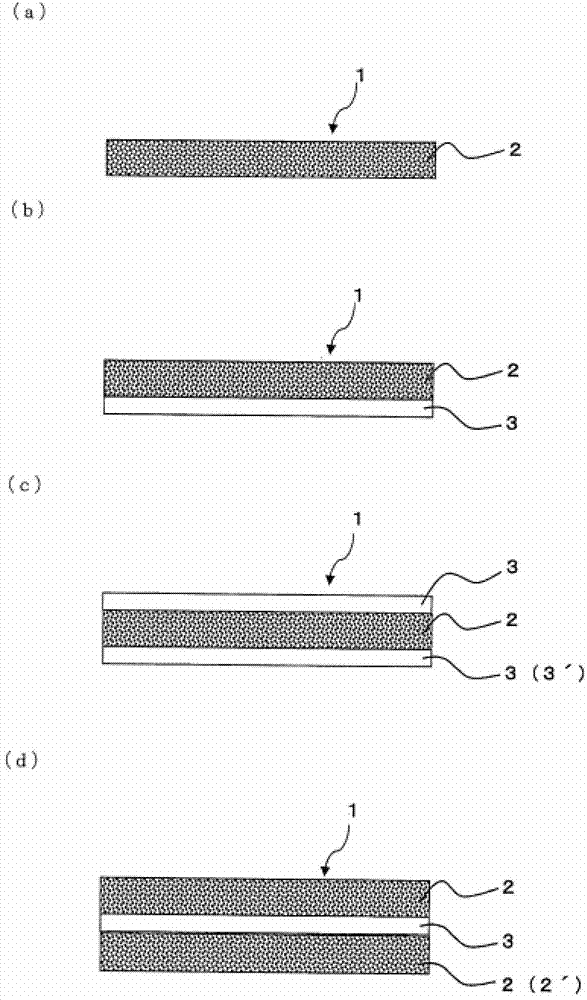Electrically insulating resin sheet for motors and process for production thereof
A technology of electrical insulation and manufacturing method, which is applied in the field of electrical insulating resin sheets for motors and its manufacturing, can solve the problems of reduced coil slot fill rate in motors, failure to obtain high output, and reduced flexibility of resin sheets, etc., to achieve suppression Effects of degradation, high partial discharge inception voltage, and excellent electrical insulation
- Summary
- Abstract
- Description
- Claims
- Application Information
AI Technical Summary
Problems solved by technology
Method used
Image
Examples
Embodiment 1
[0124] A polyetherimide resin (trade name "ULTEM1000" manufactured by Saudi Basic Industries Corporation, Tg217° C. specific gravity 1.27) was formed into a single-layer sheet with a thickness of 120 μm using a twin-screw extruder. Carbon dioxide was impregnated by throwing the unfoamed single-layer sheet into a 500 cc pressure-resistant container and keeping the inside of the tank in a carbon dioxide atmosphere at 200° C. and 25 MPa for 0.5 hour. Then, after the sheet was returned to atmospheric pressure at 300 MPa / sec, a porous resin layer made of polyetherimide with a thickness of 200 μm was obtained. The obtained porous resin layer had an average cell diameter of 4.1 μm, a porosity of 55%, and a relative permittivity of 1.8 (1 GHz).
Embodiment 2
[0126] Polyetherimide resin (trade name "ULTEM1000" manufactured by Saudi Basic Industries Corporation, Tg217°C specific gravity 1.27) and polypropylene glycol as a phase separation agent (trade name "UNIOL D-400" manufactured by NOF CORPORATION, average molecular weight 400 ) was dissolved in N-methyl-2-pyrrolidone (NMP) at a weight ratio of 100:75 to obtain a thermoplastic resin composition with a solid content concentration of 20%. This thermoplastic resin composition was applied using an applicator, and then dried at 110° C. for 10 minutes to evaporate and remove NMP to obtain a thermoplastic resin sheet with a thickness of 100 μm.
[0127] Put this thermoplastic resin sheet into a 500cc pressure-resistant container, pressurize to 25MPa in an atmosphere of 25°C, and then inject and discharge carbon dioxide at a flow rate of about 15 liters / minute to maintain the pressure. The polypropylene glycol was extracted for 5 hours to form a porous resin layer made of polyetherimide...
Embodiment 3
[0129] Polyetherimide resin (trade name "ULTEM1000" manufactured by Saudi Basic Industries Corporation, Tg217°C specific gravity 1.27) and polyetherimide resin (trade name "ULTEMXH6050" manufactured by Saudi Basic Industries Corporation, specific gravity 1.30 Tg247°C) A 200-μm-thick porous resin layer was obtained in the same manner as in Example 1, except that a single-layer sheet with a thickness of 120 μm was obtained by kneading with a twin-screw extruder at a mass ratio of 40:60. The obtained porous resin layer had an average cell diameter of 3.9 μm, a porosity of 49%, and a relative permittivity of 1.9 (1 GHz).
PUM
| Property | Measurement | Unit |
|---|---|---|
| diameter | aaaaa | aaaaa |
| glass transition temperature | aaaaa | aaaaa |
| thickness | aaaaa | aaaaa |
Abstract
Description
Claims
Application Information
 Login to View More
Login to View More - R&D
- Intellectual Property
- Life Sciences
- Materials
- Tech Scout
- Unparalleled Data Quality
- Higher Quality Content
- 60% Fewer Hallucinations
Browse by: Latest US Patents, China's latest patents, Technical Efficacy Thesaurus, Application Domain, Technology Topic, Popular Technical Reports.
© 2025 PatSnap. All rights reserved.Legal|Privacy policy|Modern Slavery Act Transparency Statement|Sitemap|About US| Contact US: help@patsnap.com


